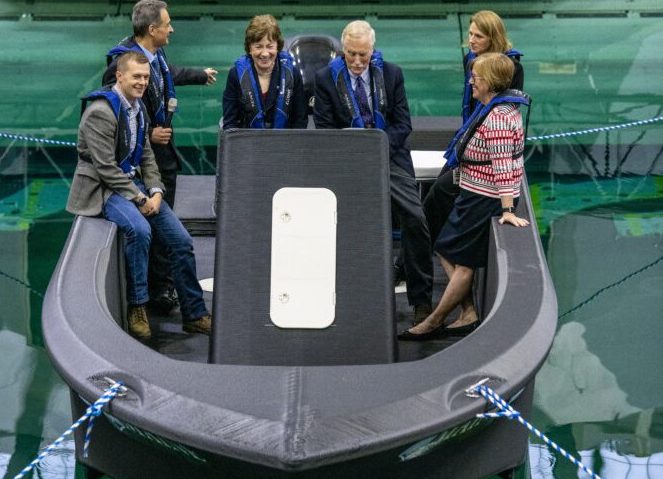By: PAUL HANAPHY
Publisher: 3D Printing Industry
Date: May 17th, 2021
Built by Dagher’s team as part of a federal research project into developing stronger and more eco-friendly transport networks, the bio-based barriers are designed to protect coastal infrastructure from flood-related damage. In future, the researchers intend to leverage the modularity of their approach to 3D print and deploy a 75-foot breakwater, with the potential to reduce tidal impacts by 50%.
“[These building techniques] are key to achieving a cost-effective, resilient transportation system of the future,” said Dagher. “We can’t keep building it the same way and expect a different result. As we rebuild our roads and bridges, we have a once-in-a-lifetime opportunity to use more durable, more sustainable advanced materials including composite materials.”
“THE SUMMARY IS, PLEASE INVEST IN R&D. THAT’S HOW WE’LL BUILD BETTER TRANSPORTATION INFRASTRUCTURE IN THE FUTURE.”
UMaine’s 3D printing expertise
While it’s currently unclear if the technology behind the team’s a flood defense devices is new, or if the barriers themselves represent a novel application of an existing approach, UMaine has been a keen contributor within the field of maritime 3D printing for some time.
As early as October 2018, the university’s ASCC was awarded $500,000 by the Maine Technology Institute (MTI) to develop a means of 3D printing large-scale marine vessels. This research came to fruition in 2019, when UMaine and the ASCC used the world’s largest prototype polymer 3D printer to create a record-breaking boat, which at the time, smashed no fewer than three Guinness World Records.
Nicknamed ‘3Dirigo,’ the 25-foot pleasurecraft was actually built using a machine developed by Ingersoll Machine Tools, out of a novel cellulose-based feedstock co-created by UMaine and Oak Ridge National Laboratory. Formulated out of up to 50% cellulose fiber, the team’s material is reportedly non-toxic and conductive, while still exhibiting a mechanical strength similar to that of aluminum.
Using their bio-based feedstock, researchers at UMaine have since been awarded $2.8 million by the U.S. Department of Energy to develop large-format 3D printed turbine blade molds. Compared to conventional tooling, the team anticipate achieving cost savings of up to 50% during the project, and it now appears that they’re applying their maritime expertise in a similar area, to develop novel flood-inhibiting barriers.

UMaine takes center stage
On May 13 2021, Dagher was invited by the Senate’s Transportation Appropriations Subcommittee, as one of four experts to provide testimony on how U.S. transport utilities can be protected from the impact of climate change. In particular, Dagher’s was there to present the new materials and techniques that his UMaine team has been developing, as part of a forty-project scheme across Maine and New England.
Overseen by the Transportation Infrastructure Durability Center, the wider program was set up to find a means of extending the life of existing transport networks, as well as designing new, more durable roads, bridges and ports. For its part, UMaine presented four composite-based innovations, including a ‘bridge in a backpack’ and U-shaped supports, in addition to 3D printed breakwaters and culvert diffusers.
Built out of a bio-based material, the researchers’ diffusers are essentially designed to reduce the amount of damage caused when the tunnels running under roadways overflow, and wash-out nearby highways. By lining corroded culverts with 3D printed diffusers, the UMaine team believe it’s possible to increase their waterflow by 40%, thus minimizing any damage inflicted on surrounding infrastructure.

In fact, the team estimates that increasing the drainage flow of culverts could save the U.S. government millions of dollars each year in bridge replacements, while their 3D printed devices can be made-to-measure using sustainable materials. To demonstrate the potential of their diffusers, the researchers intend to install one near Maine by the summer of 2021.
On a larger scale, the UMaine team have also developed floating breakwaters with flood defense in mind, but instead of protecting on-land facilities, they’re built to shield coastal infrastructure. The 3D printed barriers feature a modular design, allowing them to be constructed and deployed at short notice, before adjusting to water level, and protecting harbors from up to 50% of the impact of a tidal wave.
Having already established the functionality and expandable nature of their breakwaters, the researchers now aim to scale them into a 75-foot long prototype, that will be tested for its force displacement capabilities near the Maine coast.
Those interested in watching Dagher’s presentation to the Senate hearing in full, as well as those of the project’s other contributors, can do so here.
Plant-based 3D printing advances
UMaine may have become somewhat of a bio-based maritime 3D printing specialist, but its researchers are far from the only ones using cellulose to build sustainable structures. As part of the EU-funded NOVUM project, for instance, scientists are currently working on 3D printing cellulose-based parts, with potential applications in the automotive, marine and electrical insulation sectors.
Elsewhere, researchers from the University of Stuttgart, University of Virginia and Koc University have combined their expertise to develop 3D printable cellulose-based filaments. By tweaking the mechanical and rheological characteristics of their material, the team were ultimately able to create samples with pre-programmed deformation profiles.
On a similar note, a team of scientists from Simon Fraser University (SFU), British Columbia University, and the Swiss Federal Laboratories for Materials Science and Technology (EMPA), have managed to 3D print wood-derived electronics. With further R&D, the researchers believe that their cellulose material could yield sustainable sensors, or be used to replace the plastic within standard PCBs.
To stay up to date with the latest 3D printing news, don’t forget to subscribe to the 3D Printing Industry newsletter or follow us on Twitter or liking our page on Facebook.
Are you looking for a job in the additive manufacturing industry? Visit 3D Printing Jobs for a selection of roles in the industry.
Comments: It is really awesome to see all the applications that 3D printing is in and what it will be in the future. This allows me to really think about what I can do and how I can push the envelope even more.




